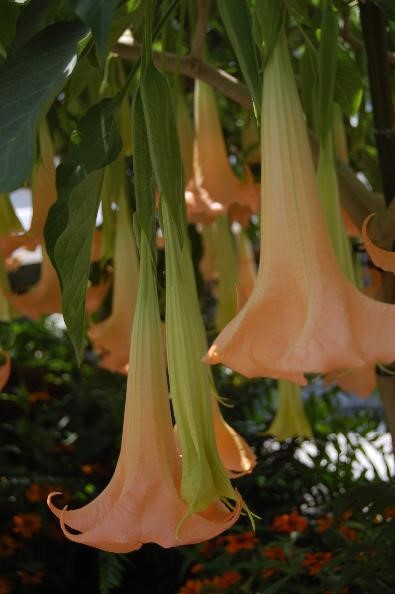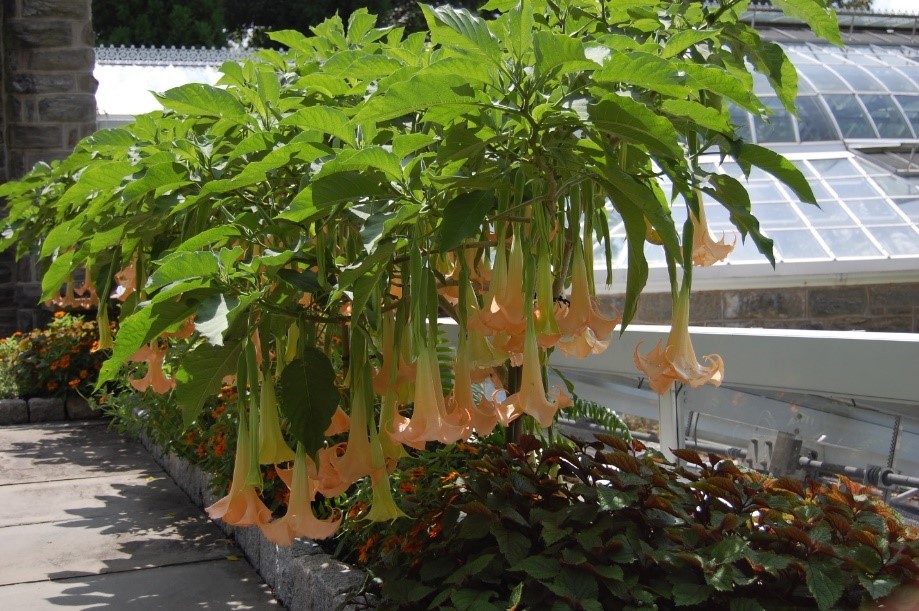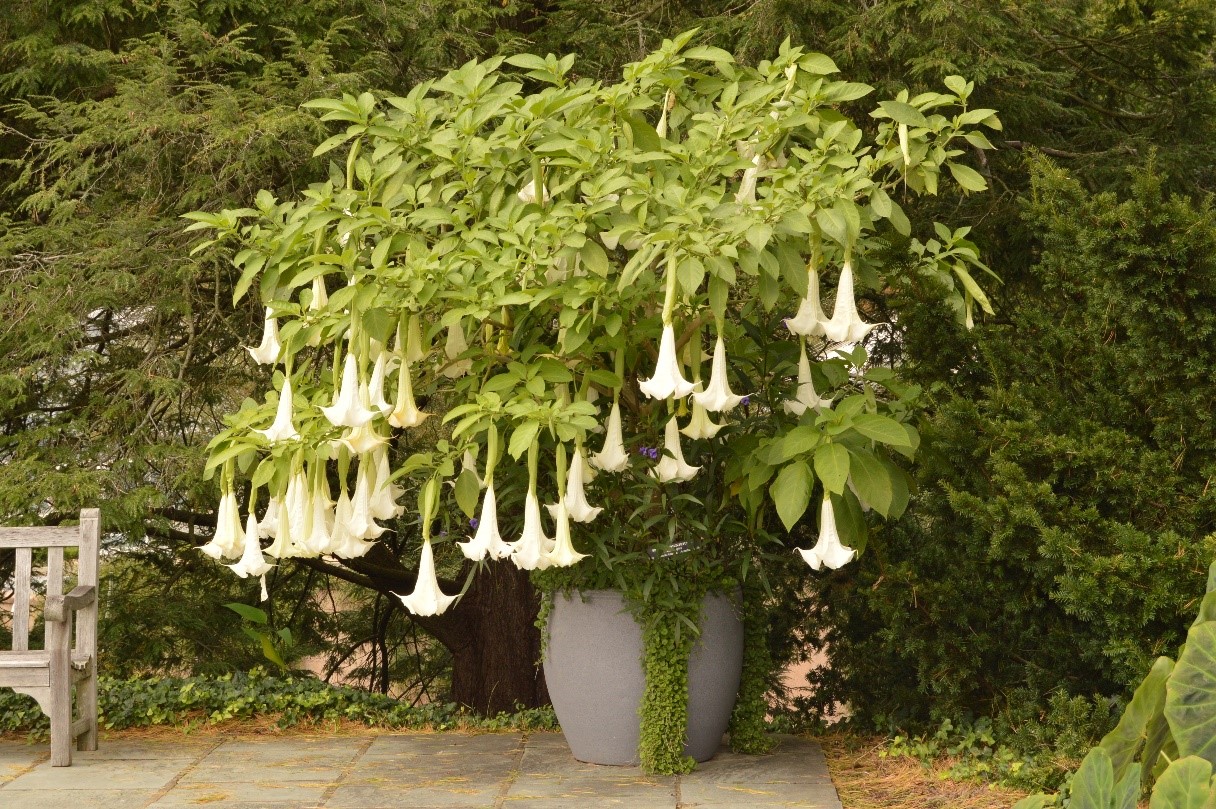Trumpets From the Heavens
A ‘Tropical’ is a term used for plants that are a perennial in their native regions that typically hover somewhere close to the equator. Due to their lack of frost tolerance, they serve more as annuals in temperate gardens. Of course, plant lovers try to make them perennials by bringing them indoors for the colder months. Personally, I think it is more to see if they can show off their horticultural acumen by actually saving the plant than saving the cost of buying anew come the spring. There are in fact numerous Tropicals that the gardener can overwinter indoors, but none is probably as spectacular in size or bloom as is Brugmansia or Angels Trumpet!
Brugmansia is a member of the Solanaceae or Nightshade family of which the Tomato, Pepper and Eggplant are very renowned members. Currently, there are seven known species that were ‘originally’ native along the Andes from Venezuela to Northern Chile and SE Brazil. I emphasize ‘originally’ since the seven species are no longer found in the wild and are now classified as extinct! The cause for extinction is possibly due to the loss of the animal or insect responsible for seed dispersal or perhaps the result of over-harvesting of the species for the powerful Tropane Alkaloids found in the plants tissues.

Brugmansia is closely related to another alkaloid bearing plant named Datura. In fact, Angels Trumpet was initially named Datura by the Swedish Botanist and Physician Carl Linnaeus (1707-1778) in 1753. It was not until 1805 that Christiaan Hendrik Persoon (1761-1836), who resided for most of his life in Paris and was most noted for his classification of mushrooms, properly classified this plant. The genus honors the Dutch botanist and physician Sebald Justin Brugmans (1763-1819). The common name of Angel’s Trumpet comes from the dangling, 6-10” long trumpet shaped flowers that resemble musical instruments pointed downward from Heaven (as seen above and at right). On the flipside Datura is often called Devil’s Trumpet since the 4-6” long flowers point upwards, resembling trumpets blaring up from the depths of the underworld. Clearly, Brugmansia received the more marketable name!
Aside from the orientation of the flower, there are numerous other differences. Unlike Datura, which consists of several herbaceous species reaching 4’ tall, Brugmansia species and hybrids are woody plants that have the potential to reach impressive heights of 10-30+ feet, depending upon the cultivar or species. The ovate foliage is arranged alternately and typically is lightly pubescent. For the selection ‘Snowbank’, the foliage is trimmed with a wide white border that nicely compliments the salmon flowers and has a far more robust border than the selection ‘Variegata’. The flowers have a lemony fragrance in the early evening to attract pollinating hawkmoths and bats, with the flower persisting for 2-6 days. The individual colors range from white to pink, yellow, orange and even maroon. The flowers typically appear in waves, separated by a 2-3 week rest period, allowing the plant to store up reserves for the next floral flush. By contrast, Datura features white or purple flushed flowers that occasionally appear as double. These flowers also open in the evening and are attractively fragrant.
With its impressive size and relatively rapid rate of growth, it is no wonder that Brugmansia requires nutrient rich soils and sustained irrigation. Containers are a nice way to elevate and display the flowers on younger plants, since it brings the flower up to the gardeners and allows one to peer upwards into the flower (as seen below with ‘Cypress Gardens’ and below with ‘Frosty Pink’).
When using containers, it is important to situate the plants in slightly larger containers, reducing the chance of the pot becoming root bound and drying out more rapidly. Flowering is greatly reduced should the plant experience drought! Container plants should also be on a weekly regiment of liquid fertilizer since slow release pellets do not provide a sufficient amount of nutrients for the plants. Locate Brugmansia in full sun for optimal growth, although light shade will also provide respectable results. If you are among those dedicated gardeners who wish to overwinter the plant, allow the plant to be defoliated by the first few autumn frosts before bringing the plant inside for the winter. Allowing the plant to become ‘frosted’ induces dormancy in the plant. It also results in the leaves dropping from the plant, which removes the food source for white fly, aphids, mealy bug and scale. Bring the plant indoors into a cool, dark location such as a basement, an attached but unheated garage or a cool closet and reduce the watering such that the soil remains only lightly moist. The lack of sunlight will aid in keeping the plant dormant and the dry soils will prevent root decay. Come spring, reintroduce the plant to light, prune off any dead wood, up-pot into a larger container and restart the fertilizing regiment!
Most of the plants available for the Garden are hybrids, rather than a species, which explains the obvious absence herein of species descriptions. Plants will also root fairly easily from cuttings, should a friend have a selection that you are envious of growing in your garden! Although far from dangerous in a garden display, care should be taken when handling cuttings. The Tropane Alkaloids mentioned earlier include strychnine, atropine and scopolamine, which in small quantities yield a numbing effect on the brain while larger quantities result in violent hallucinations and death. Obviously, great care and plastic/rubber gloves needs to be used while working with cuttings! Fortunately, the presence of the alkaloids does make the genus very resistant to deer browse.
A plant with great presence, intriguingly beautiful flowers and a sincere note of respect, Brugmansia has proven to be a wonderful plant for decorating the garden and wowing visitors. Should you be looking for a Tropical that provides the visual equal of horns sounding from the heavens above, this is the plant for you!





